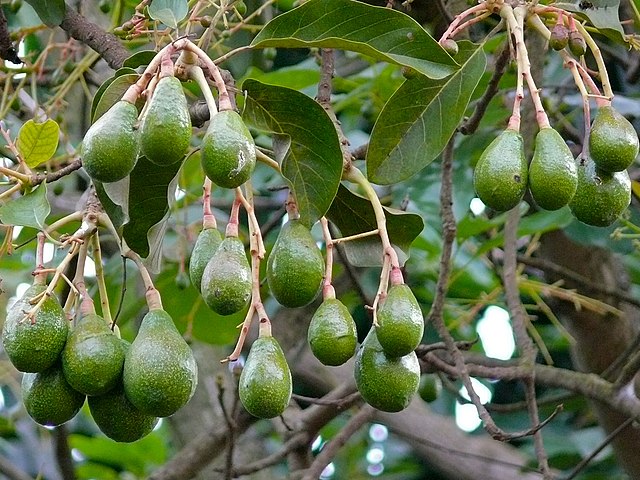Avocado, alligator pear
Punica granata
Family: Lauraceae | Place of Origin: The eastern and central highlands of Mexico and highland areas of Guatemala
Origins and history:
Origin:
The oldest archeological record is from Coxcatlan, Mexico in about 10,000 BCE. Cultivation of the fruit is believed to have started in about 8,000 BCE.
Distribution:
During the 16th century, early European travelers found cultivated avocados and spread them to Central and South America. In 1650, Spaniards introduced avocado to Jamaica, then, in the 1700s and 1800s it was distributed to the African and Asian tropics. Avocado was first introduced to the USA in 1833 in Florida. Now, commercial production of avocado ranks as 17th in the world. The largest producers are Mexico, the USA (mostly in California), Indonesia, Dominican Republic, Colombia, Chile, Peru, and Brazil.
Traditional uses:
Avocado fruit is a traditional staple in Guatemala and is considered a daily food. It is also of traditional importance in Mexico where it is used to make dishes like guacamole, salsa verde, an ingredient in cold soups, and topped on black beans, enchiladas, and tacos. The leaves have also been used traditionally as a spice for barbacoa in Mexico. It was also originally believed that Avocados were a fertility food due to their shape.

Identification characteristics
- Tree: The avocado tree (Persea americana) is in the family Lauraceae. The average height for this tree varies from 15 to 18 meters. Its preferred habitat is in the subtropics.
- Leaves: The leaves are dark green, glossy, and range from elliptic (oval) to egg shape. The length of the leaves are about five to 20 centimeters long and three to 12 centimeters wide. The leaves are simple and spirally arranged. When crushed, they smell like anise.
- Flowers: The flowers are small and green in color. They are arranged in a dense clump called an inflorescence. Each flower has nine stamens, which is the male, pollen producing organ of a flower, and one single-celled ovary. The flowers are considered dichogamous, meaning that the male and female parts of the flower mature separately, and each flower only opens twice.
- Fruit: Avocado fruits, also called alligator pears, are four to 12 centimeters long and the shape ranges from round to egg shaped with a long neck. The fruit is considered a berry. The skin, or exocarp, can be dark green, purple, brown, or black. Inside the fruit is a single, large seed that is loose in the seed cavity.
Uses and preparation
Food: Avocado is most commonly eaten by scooping out the pulp and eating it raw or as an ingredient in dishes. It is used as an ingredient in salads and fruit salads. In parts of Asia, it is commonly made into ice cream or a shake by adding sugar and chocolate.
Liquid: It has been known to be an ingredient in a liqueur called advocaat.
Cosmetics/medicine: The extracted oil and the pulp can also be used for lotions, face creams, skin care products, cosmetics, and hair products. The oil can be used topically to relieve skin problems like eczema, dry scalp, and irritations and it is also used to increase collagen and for its anti-bacterial properties.